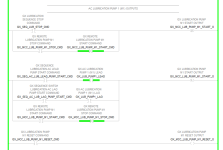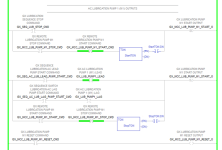I understand your points. This is a question of philosophy.
I agree with the "all caps" but we've been doing that since 20 years now, not easy to get the older ones and some customers to change. On that project at least I managed to remove the all CAPS from the screens since it's not our main customer and I can "try" things. I like it better this way.
For the UDTs, first I simply just don't like to use them, always had trouble back tracking those tags when they're hidden in a UDT. Also, most of our projects ends up with enough customization needed that many times 2 of the same devices are different. It's not like it's a line-up of 40 VFD from the same brand with 30 times the same IOs I need to pull from there.
So, I don't have enough devices that are replicated to "justify" to go this way. To pile on that, in that particular project, I need to remap in Modbus, which means that I'd need to address the binaries as integers if using UDTs, and I'd need an integer for the BI and another one for the BO since they are not in the same address pool, meaning probably 2 UDTs for... 2 pumps? With 4 BI and 2 BO I can do it by hand, I don't think it's worth it. I haven't tried but that would probably lead to a mess in SMC and InTouch (since we're only using Modbus, not ABCIP).
For the tag names, I have my habits with Schneider FBD where we don't see the descriptions as easily as on a Rockwell Ladder, so we let the tag tell the story. 99% of the time I don't need to refer to the SCADA List to use the tag I want since we've been using the same structure for a while now, and most of the points are always present. Example I know that I can type GX_SEQ_AC_LUB_LAG_PUMP_START_CMD to call the start for the lag pump. I know that I can type GX_PM_COM_F to interlock a logic when I lose the comm with the power meter. I don't need to look for it.
I remember a project we were going to rehab where it was BI0000...BI1000 as tag names, or something like that, don't remember the exact range. Even with the descriptions there, it's a pain to work with that. It was a Schneider FBD project, so all I was seeing was the tags on blocks, I needed to select each tag and check the proprieties to see what it was. With our own tags, I can look at an 8 inputs OR FDB and just with the tags I can tell you what the block is doing and what are all the inputs since the tags are telling the story. And this is why I do that.
We do 95% Schneider PLC, it's my first units with a Rockwell PLC since we don't recommand it when the customer wants to use Modbus, but the customer really wanted Rockwell PLCs for some reason. So in order to not confuse everyone that work with us, we mostly try to replicate what we're usually doing, but in LD since the FDB editor of Rockwell is slowing down the CPU and is a mess to work with.





